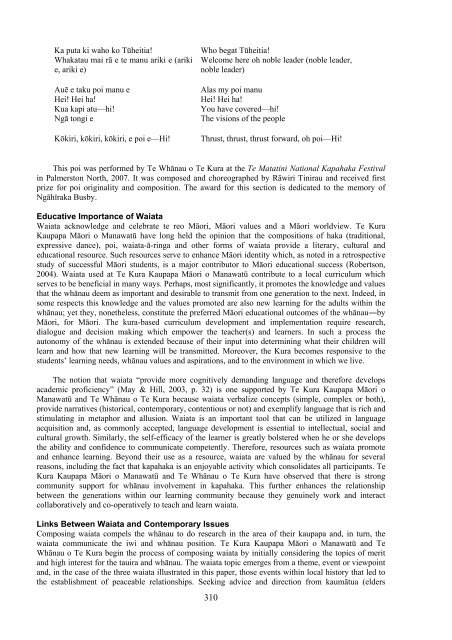traditional knowledge conference 2008 te tatau pounamu
traditional knowledge conference 2008 te tatau pounamu
traditional knowledge conference 2008 te tatau pounamu
You also want an ePaper? Increase the reach of your titles
YUMPU automatically turns print PDFs into web optimized ePapers that Google loves.
Ka puta ki waho ko Tūheitia!Whakatau mai rā e <strong>te</strong> manu ariki e (arikie, ariki e)Auē e taku poi manu eHei! Hei ha!Kua kapi atu—hi!Ngā tongi eKōkiri, kōkiri, kōkiri, e poi e—Hi!Who begat Tūheitia!Welcome here oh noble leader (noble leader,noble leader)Alas my poi manuHei! Hei ha!You have covered—hi!The visions of the peopleThrust, thrust, thrust forward, oh poi—Hi!This poi was performed by Te Whānau o Te Kura at the Te Matatini National Kapahaka Festivalin Palmerston North, 2007. It was composed and choreographed by Rāwiri Tinirau and received firstprize for poi originality and composition. The award for this section is dedica<strong>te</strong>d to the memory ofNgāhīraka Busby.Educative Importance of WaiataWaiata ac<strong>knowledge</strong> and celebra<strong>te</strong> <strong>te</strong> reo Māori, Māori values and a Māori worldview. Te KuraKaupapa Māori o Manawatū have long held the opinion that the compositions of haka (<strong>traditional</strong>,expressive dance), poi, waiata-ā-ringa and other forms of waiata provide a li<strong>te</strong>rary, cultural andeducational resource. Such resources serve to enhance Māori identity which, as no<strong>te</strong>d in a retrospectivestudy of successful Māori students, is a major contributor to Māori educational success (Robertson,2004). Waiata used at Te Kura Kaupapa Māori o Manawatū contribu<strong>te</strong> to a local curriculum whichserves to be beneficial in many ways. Perhaps, most significantly, it promo<strong>te</strong>s the <strong>knowledge</strong> and valuesthat the whānau deem as important and desirable to transmit from one generation to the next. Indeed, insome respects this <strong>knowledge</strong> and the values promo<strong>te</strong>d are also new learning for the adults within thewhānau; yet they, nonetheless, constitu<strong>te</strong> the preferred Māori educational outcomes of the whānau―byMāori, for Māori. The kura-based curriculum development and implementation require research,dialogue and decision making which empower the <strong>te</strong>acher(s) and learners. In such a process theautonomy of the whānau is ex<strong>te</strong>nded because of their input into de<strong>te</strong>rmining what their children willlearn and how that new learning will be transmit<strong>te</strong>d. Moreover, the Kura becomes responsive to thestudents’ learning needs, whānau values and aspirations, and to the environment in which we live.The notion that waiata “provide more cognitively demanding language and therefore developsacademic proficiency” (May & Hill, 2003, p. 32) is one suppor<strong>te</strong>d by Te Kura Kaupapa Māori oManawatū and Te Whānau o Te Kura because waiata verbalize concepts (simple, complex or both),provide narratives (historical, con<strong>te</strong>mporary, con<strong>te</strong>ntious or not) and exemplify language that is rich andstimulating in metaphor and allusion. Waiata is an important tool that can be utilized in languageacquisition and, as commonly accep<strong>te</strong>d, language development is essential to in<strong>te</strong>llectual, social andcultural growth. Similarly, the self-efficacy of the learner is greatly bols<strong>te</strong>red when he or she developsthe ability and confidence to communica<strong>te</strong> compe<strong>te</strong>ntly. Therefore, resources such as waiata promo<strong>te</strong>and enhance learning. Beyond their use as a resource, waiata are valued by the whānau for severalreasons, including the fact that kapahaka is an enjoyable activity which consolida<strong>te</strong>s all participants. TeKura Kaupapa Māori o Manawatū and Te Whānau o Te Kura have observed that there is strongcommunity support for whānau involvement in kapahaka. This further enhances the relationshipbetween the generations within our learning community because they genuinely work and in<strong>te</strong>ractcollaboratively and co-operatively to <strong>te</strong>ach and learn waiata.Links Between Waiata and Con<strong>te</strong>mporary IssuesComposing waiata compels the whānau to do research in the area of their kaupapa and, in turn, thewaiata communica<strong>te</strong> the iwi and whānau position. Te Kura Kaupapa Māori o Manawatū and TeWhānau o Te Kura begin the process of composing waiata by initially considering the topics of meritand high in<strong>te</strong>rest for the tauira and whānau. The waiata topic emerges from a theme, event or viewpointand, in the case of the three waiata illustra<strong>te</strong>d in this paper, those events within local history that led tothe establishment of peaceable relationships. Seeking advice and direction from kaumātua (elders310
















